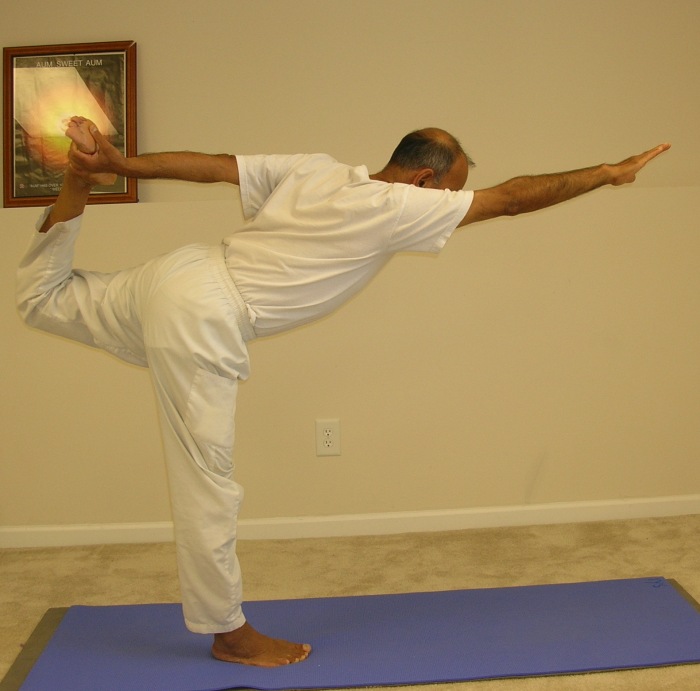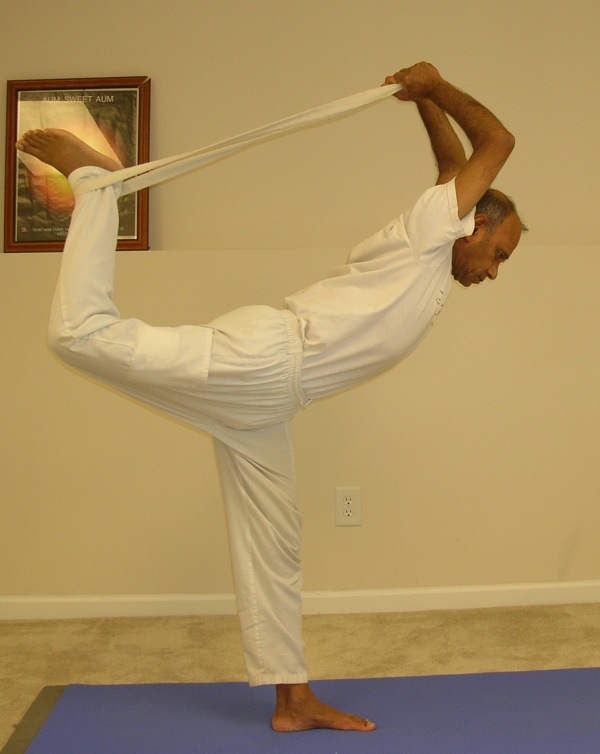
Natarajasana (Dancer’s Pose)
Nataraja (nata means a dancer and raja means the king or the lord), king-dancer, is the name of Lord Shiva (one of the trinity of Hindu gods – Shiva, Vishnu, and Brhma). In addition to being the dissolver of the universe, Shiva was also the Lord of dance and created over a hundred dances. Natarajasana – नटराजासन – is dedicated to Lord Shiva.
Natarajasana is an elegant-looking balancing pose which also involves a great stretch for the upper thighs (quads) as well as the spine and the shoulders.
Step by Step
- Come to a comfortable standing position with the feet together and arms alongside the body. Inhale, shift your weight onto your right foot, and, bending the left knee, lift your left foot toward your left buttock. Pull the right knee cap up to keep the standing leg straight and strong.
- Reach back with your left hand and grasp the inside of the left foot.
- Stretch the right arm in front and keep it parallel to the floor throughout the pose
- Begin to lift your left foot up, and back by pressing into the hand with the foot, away from your torso. Try to extend the left thigh behind you and bring it parallel to the floor.
- Raise the left foot up behind you as high as you comfortably can and keep bending forward slightly at the same time.
- While in the final pose, make the effort to keep both the buttocks at the same level. Stay in the pose for about six to eight breaths
- To come out of the pose, slowly release the left foot and the right arm down and come back to the original standing position.
- Repeat the above steps on the other side
Nataraja Variation (with strap)

Natarajasana with strap
- In order to provide additional stretch for the shoulders, you can use a strap.
- Use the strap to hook the left ankle behind you and hold the strap from above your head.
- Begin to lift your left foot up, and back by pressing into the strap with the foot, away from your torso. Try to extend the left thigh behind you and bring it parallel to the floor.
- Stretch the shoulders up and back and keep bending forward slightly at the same time.
- While in the final pose, make the effort to keep both the buttocks at the same level. Try to maintain the final pose for about six to eight breaths
- To come out of the pose, slowly release the left foot and the arms down, release the strap, and come back to the original standing position.
- Repeat the above steps on the other side
Benefits
- Provides a great stretch for the shoulders and chest
- Stretches the thighs – quads and hamstrings, groins, and abdomen
- Strengthens the leg that supports the body weight
- Improves physical balance and mental focus
[…] balancing poses which are done in a standing position – for example the Tree Pose or the Dancer Pose. Today’s post is about the Tiptoe balancing pose ( – Padangushthasana – […]
Hi Subhash,
happy New Year to you and Manju! Wishing you a healthy and peaceful 2015.
I am reading your monthly Newsletter and toast two times, it caught my attention because it is focusing on Quads which I need to do! Since our new home does not have stairs as part of regular lifestyle ( have a loft, which we use as a yoga studio), compared to our old home, my quads don’t get exercise as much and I can feel they are getting weaker! So your focus on quad exercises is very timely and I am using it.
So, thank you! It is funny how fast our body loses the muscle strength!
Kalpana
Hi Kalpana,
Hope you are enjoying your new home! I am so glad that you found the post on quads useful in a timely manner. How big is the loft? Are you planning to teach yoga to friends and neighbors soon?
Hope to talk to you soon and catch up with you guys.